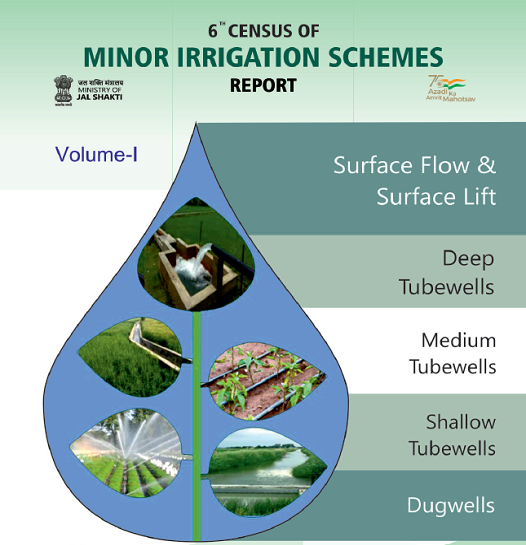The Ministry of Jal Shakti, Department of Water Resources, River Development and Ganga Rejuvenation today released the report on the 6th census on minor irrigation schemes. As per the report, 23.14 million minor irrigation (MI) schemes have been reported in the country, out of which 21.93 million (94.8%) are Ground Water (GW) and 1.21 million (5.2%) are Surface Water (SW) schemes. Uttar Pradesh possesses the largest number of MI schemes in the country followed by Maharashtra, Madhya Pradesh and Tamil Nadu. Leading States in GW schemes are Uttar Pradesh, Maharashtra, Madhya Pradesh, Tamil Nadu and Telangana. In SW schemes Maharashtra, Karnataka, Telangana, Odisha and Jharkhand have the highest share. GW schemes comprise dugwells, shallow tube wells, medium tube wells and deep tube wells. The SW schemes comprise surface flow and surface lift schemes.
There has been increase of about 1.42 million in MI schemes during 6th MI census as compared to 5th Census. At the national level, both GW and SW schemes have increased by 6.9% and 1.2%, respectively. Dug-wells have highest share in MI schemes followed by shallow tube-wells, medium tube-wells and deep tube-wells. Maharashtra is the leading State in dug-wells, surface flow and surface lift schemes. Uttar Pradesh, Karnataka and Punjab are the leading States in shallow tube-wells, medium tube-wells and deep tube-wells, respectively. Out of all MI schemes, 97.0% are ‘in use’, 2.1% are ‘temporarily not in use’ whereas 0.9% are ‘permanently not in use’. Shallow tube-wells and medium tube-wells lead in the category of ‘in use’ schemes. A majority of MI schemes (96.6%) are under private ownership. In GW schemes, the share of private entities in the ownership is 98.3% whereas in SW schemes the respective share is 64.2%.
For the first time, the information about gender of the owner of MI scheme was also collected in case of individual ownership. Out of all the individually owned schemes, 18.1% are owned by women. Around 60.2% schemes have single source of finance whereas 39.8% schemes have more than one source of finance. In single source of finance, majority of schemes (79.5%) are being financed by own savings of individual farmer.

A sound and reliable data base for minor irrigation schemes is essential for effective planning and policy making in this sector. With this objective, Government of India has been conducting census of minor irrigation schemes. So far, five censuses have been conducted with reference year 1986-87, 1993-94, 2000-01, 2006-07 and 2013-14 respectively. The 6th minor irrigation census with reference year 2017-18 was completed in 32 States/ UTs. The 6th MI census work was delayed due to the Covid-19 pandemic. The census work has been successfully completed now and the All India and State-wise report on 6thMI census has been published.
The census was conducted under the centrally sponsored scheme “Irrigation Census”. Detailed information on various parameters like irrigation sources (dug well, shallow tube well, medium tube well, deep tube well, surface flow and surface lift schemes), irrigation potential created (IPC), potential utilized, ownership, holding size of land by owner, devices used for lifting water, sources of energy, energy conserving devices such as sprinkler and drip irrigation, use of non-conventional energy sources such as solar pumps, wind mills etc was collected.
This report will be useful for planners, policy makers, researcher scholars, agricultural and ground water scientists, administrators & all concerned with development of irrigation and agricultural economy of the country.
All India Report: https://jalshakti-dowr.gov.in/document/all-india-report-of-6th-census-of-minor-irrigation-schemes-volume-1/
State-wise Report: https://jalshakti-dowr.gov.in/document/state-wise-report-of-6th-census-of-minor-irrigation-schemes-volume-2/
*****










